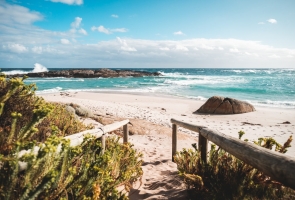Winter is the time when people plan their summer vacations. It is also the time when people who live where the seasons change start longing for a little warmth, color, and fun. It’s about this time when people start daydreaming about leaving the snow, ice, and stuffy cubicles behind and hitting the road a little family fun.
Effective travel blog writing – particularly that which involves road trips – gives the reader a host of good reasons to check out attractions that go beyond just major destinations. It gets them thinking about new experiences and adventures and the memories that will be tied to them long after.
Most people will never even know about some of the crazy little tourist traps they miss driving by unless you point them out. Some families – many, in fact – take the same trip every year. They take the same route, they stop at the same restaurants, they stay at the same hotels… and many would love to find new things to experience along the way.
Imagine your readers scrolling through one of your blog posts and seeing familiar images or reading the names of familiar destinations, but also being introduced to some great activities they never even knew existed. Most people don’t fall into routines because they lack imagination. They do it because they lack information. That is where you come in. The places you send them can add an entirely new dimension to the experience of “getting there” that they would never know otherwise.
So, how do you get and hold people’s attention when writing about road trips? Here are a few bits of advice to – pardon the pun – steer you in the right direction.
#1 – Sell the Experience
People tend to focus on the negatives when it comes to road trips: the entire family cooped up in a car, no privacy, no quiet, just miles and miles of never-ending chaos. “We just want to get there…” is a popular mantra.
Good travel writing convinces the reader that getting there is only part of the experience. Steer clear of even mentioning specific family members or family dynamics and focus on the attractions and activities you want them to discover. Once you paint the picture of the experience, use emotional language to evoke the kinds of feelings that attraction will give if you decide to stop there.
Once you’ve laid the foundation, you can bring the reader in personally. Insert the images of happy family members enjoying an entertaining or relaxing time at the tourist trap or attraction of your choice.
Try to steer clear of mentioning money unless the attraction in question is known for being a particularly good value. Let’s face it: Most attractions that cater to tourists just aren’t. The last thing you want is to remind the reader that he or she will be spending more money if they take your advice. Remember, it’s all about the experience: the feelings, the memories, the quirky stories to tell your friends. No one enjoys the experience of parting with their hard-earned cash.
#2 – Use Lots of Details
If you expect someone to steer 20 or 50 or more miles off-course to visit an “on the way” attraction, you need to give them as many reasons to take that detour as possible. If there is a good story that goes along with the attraction, tell it. If there is one specific thing it’s known for, describe it.
Use language that is both evocative and immersive. Balance the details between the attraction and the visitor. Tell the reader how tall the redwoods are, then describe what it feels like to look up and marvel at how far they stretch. Describe how much fun it is to watch the doughnuts being made, then describe how they smell. Tell the reader what it’s like watching them drizzle that sweet, buttery maple sugar icing over them. You get the idea. You also want a maple sugar doughnut now, too. I’d say I’m sorry, but I try to never apologize for doing my job…
#3 – List Activities and Attractions in Order
Give readers a followable itinerary that takes them from attraction to attraction along a specific route. Who knows! You might even inspire some folks to take a road trip for the express purpose of seeing some of the quirky things you mention in your blog firsthand.
The key here is making it easy to follow your lead. The itinerary you suggest doesn’t have to follow a straight line from Point A to Point B, but you also don’t want to force people to rack up excess miles or waste large chunks of their vacation time driving from one attraction to the next.
Suggesting stops within a few hours of each other is ideal. Very few people will have the time, money, or desire to stop at all the places you mention, but if you suggest 10 stops, most families will find at least three or four they are interested in checking out. Knowing even a general proximity between attractions will help them decide better how to plan and customize their trip.
#4 – Suggest Ways to Save Money
If you know of any travel club incentives tied to a specific attraction, mention them in your blog. Many tourist attractions offer a number of perks to attract visitors. These perks often include things like reduced hotel rates and discounts at local restaurants.
There are a nearly limitless number of promotions businesses offer with things like ticket stubs, receipts, and memberships with organizations like the American Automobile Association (AAA). This is the one time you can get away with mentioning money, so drop a few names where you can (especially if you are an affiliate or receive commissions for sending visitors to a hotel, restaurant, or attraction).
Final Takeaway
Great road trip copy – like all facets of travel copywriting – hinges on the ability to immerse the reader into the experience of taking a trip. This is why I want to issue a challenge to all travel agents and content marketers who rely on travel copy to boost their businesses: rediscover the power of the road trip this year. Need help? Reach out to BeezContent. We have an amazing team of staff writers that can help you take your readers on the road trip of a lifetime!




